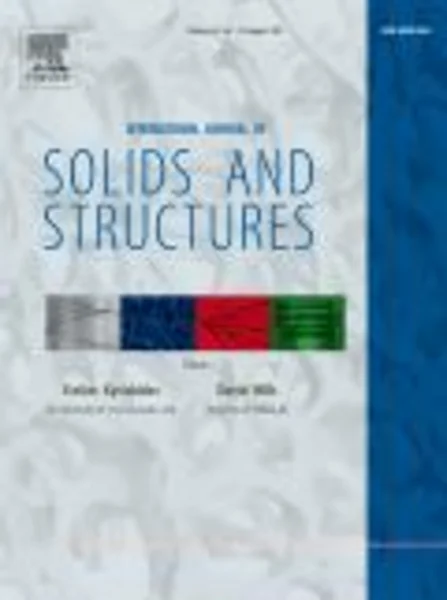-
warping of stationary and rotating heavy disks
جزئیات بیشتر مقاله- تاریخ ارائه: 1392/01/01
- تاریخ انتشار در تی پی بین: 1392/01/01
- تعداد بازدید: 712
- تعداد پرسش و پاسخ ها: 0
- شماره تماس دبیرخانه رویداد: -
a flexible circular plate with gravity as its main source of external loading is called a heavy disk. this paper studies the non-axisymmetric warping of a clamped-free heavy disk. in the theoretical formulation, von karman’s plate model is adopted to derive the equations of motion of a rotating heavy disk. in the experiment, a 51/4-inch floppy disk is used to demonstrate the non-axisymmetric deformations when the disk is either stationary or rotating. we first measured the shape of the floppy disk when it was stationary. it was observed that two non-axisymmetric deformations coexisted, one with shape cos 2θ and the other cos 3θ. we next rotated the floppy disk. it was observed that when the floppy disk started with shape cos 2θ, the deformation switched to shape cos 3θ as the rotation speed increased to 303 rpm. as the speed continued to increase, the shape cos 3θ persisted all the way up to 1010 rpm. beyond that the disk deformation became axisymmetric until 1313 rpm. beyond 1313 rpm, aeroelastic flutter started to kick in and equilibrium state was no longer achievable. the rotation speed was then reduced gradually from high speed to 0. it was found that the deformation remained cos 3θ all the way, instead of switching back to the cos 2θ shape the disk started out with in the first place. the coexistence of two stable non-axisymmetric deformations of the stationary disk and the hysteresis behavior of the rotating disk observed in the experiment are consistent with theoretical predictions.
مقالات جدیدترین رویدادها
-
استفاده از تحلیل اهمیت-عملکرد در ارائه الگوی مدیریت خلاقیت سازمانی و ارائه راهکار جهت بهبود
-
بررسی تاثیر ارزش وجوه نقد مازاد بر ساختار سرمایه شرکت های پذیرفته شده در بورس اوراق بهادار تهران
-
بررسی تأثیر سطح افشای ریسک بر قرارداد بدهی شرکت های پذیرفته شده در بورس اوراق بهادار تهران
-
بررسی تأثیر رتبه بندی اعتباری مبتنی بر مدل امتیاز بازار نوظهور بر نقد شوندگی سهام با تأکید بر خصوصی سازی شرکت ها
-
تأثیر آمیخته بازاریابی پوشاک ایرانی بر تصویر ذهنی مشتری پوشاک ایرانی (هاکوپیان)
-
تعمیم برخی از توزیع های نمایی شده با کاربردهای آن
-
کاربردی تر کردن بتن غلتکی در صنعت روسازی کشور
-
تدوین مدل شبیه سازی-بهینه سازی چند هدفه به منظور یافتن مساحت های بهینه bmp: کاربرد مدل چانه زنی بردا
-
فسخ قراردادهای پیمانکاری توسط کارفرما در شرایط عمومی پیمان
-
numerical evaluation of soft clay reinforced by geosynthatic encased stone column
مقالات جدیدترین ژورنال ها
-
مدیریت و بررسی افسردگی دانش آموزان دختر مقطع متوسطه دوم در دروان کرونا در شهرستان دزفول
-
مدیریت و بررسی خرد سیاسی در اندیشه ی فردوسی در ادب ایران
-
واکاوی و مدیریت توصیفی قلمدان(جاکلیدی)ضریح در موزه آستان قدس رضوی
-
بررسی تاثیر خلاقیت، دانش و انگیزه کارکنان بر پیشنهادات نوآورانه کارکنان ( مورد مطالعه: هتل های 3 و 4 ستاره استان کرمان)
-
بررسی تاثیر کیفیت سیستم های اطلاعاتی بر تصمیم گیری موفق در شرکتهای تولیدی استان اصفهان (مورد مطالعه: مدیران شرکتهای تولیدی استان اصفهان)
-
کاوشی در اهداف آزمایش های الهی با تمرکز بر گزاره های قرآنی- روایی
-
بررسی اثربخشی آموزش گروهی مدل abc الیس بر تعلل ورزی دانشجویان
-
بررسی تأثیر سهامداران عمده بر رابطه بین محافظه کاری حسابداری و ارزش نگهداشت وجه نقد
-
کاربرد چندرسانه در تدریس ریاضی یک ایده ی خلاقانه
-
investigation of k-ε turbulent models and their effects on offset jet flow simulation




سوال خود را در مورد این مقاله مطرح نمایید :